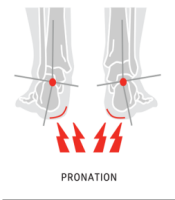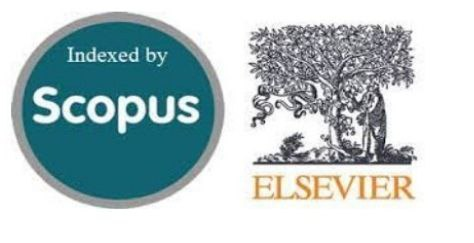The Effect of Non-prescription Orthotics on Walking Gait in Participants with Excessive Pronation
Keywords:
Insole Orthotics, Pronation, GaitAbstract
Background: Insole orthotics are prescribed to correct human body position during both the standing position and the motion of gait. Also, they are being applied for people who have forefoot abduction and arch deformation. However, a little is known about the relationship between forefoot and arch orthotic correction and the alternation in foot biomechanics. Objectives: This study was aimed to determine the effect of non-prescription insole orthotics in walking gait parameters. Methods: It was a quasi- experimental with pre-test, post-test design study. Twelve volunteer participants (41 ± 17 y), 10 men and two women, participated in this study. Three-dimensional (3D) cameras were used to do motion capture through those markers placed on lower body segments. Seven segments such as: Hip, left and right thigh, left and right shank, left and right foot were used for labelling in this study, which was measured with Vicon T-Series cameras at 250 Hz. The participants did walk in three different phases: Barefoot, running shoe, running shoe with a non-prescription orthotic inside. t-test was used to analyse the data. Results: The paired t-test results indicated that there is significant difference in cadence, step length and stride length for running shoe, and non-prescription orthotics compare to those of barefoot (P ≤ 0.05). Additionally, it was found that, non-prescription orthotics resulted in higher step length and stride length, and less cadence (P ≤ 0.05). On the other hand, But, no significant changes were found for non-prescription orthotics (P ≥ 0.05). Conclusions: It was concluded that cadence, step length and stride length were improved in running shoe compared to non-prescription orthotics group. But there were not any significant differences between running shoe and non-prescription orthotics.
Downloads
References
1. Okamoto H, Taniguchi H. Development of Pneumatic Exercise Device
for the Range of Motion in the Ankle Joint. 2022 IEEE/SICE International
Symposium on System Integration (SII). city of Narvik, Norway. IEEE;
2022. p. 585–9.
2. Ghani NS, Abd Razak NA, Usman J, Gholizadeh H. Foot over Pronation
Problem among Undergraduate Students: A Preliminary Study. Sains
Malays. 2020;49(7):1651–62. https://doi.org/10.17576/jsm-2020-4907-16.
3. Donatelli RA, Hurlburt C, Conaway D, St Pierre R. Biomechanical foot orthotics: a retrospective study. J Orthop
Sports Phys Ther. 1988;10(6):205–12. [PubMed ID: 18796957].
https://doi.org/10.2519/jospt.1988.10.6.205.
4. Tiberio D. Pathomechanics of structural foot deformities. Phys Ther. 1988;68(12):1840–9. [PubMed ID: 3194451].
https://doi.org/10.1093/ptj/68.12.1840.
5. Stergiou N, Decker LM. Human movement variability, nonlinear
dynamics, and pathology: is there a connection? Hum Mov
Sci. 2011;30(5):869–88. [PubMed ID: 21802756]. [PubMed Central ID:
PMC3183280]. https://doi.org/10.1016/j.humov.2011.06.002.
6. Dahle LK, Mueller MJ, Delitto A, Diamond JE. Visual assessment
of foot type and relationship of foot type to lower extremity injury. J Orthop Sports Phys Ther. 1991;14(2):70–4. [PubMed ID: 18796826].
https://doi.org/10.2519/jospt.1991.14.2.70.
7. Bhuyan D, Kumar K; Information Resources Management Association
(USA). A Brief History of Prosthetics and Orthotics of the Lower Body
and Their Types. Research Anthology on Emerging Technologies and Ethical Implications in Human Enhancement. Hershey, USA: IGI Global; 2021.
p. 365–80. https://doi.org/10.4018/978-1-7998-8050-9.ch018.
8. Bennell KL, Bowles KA, Payne C, Cicuttini F, Williamson E, Forbes A, et
al. Lateral wedge insoles formedial knee osteoarthritis: 12month randomised controlled trial. BMJ. 2011;342:d2912. [PubMed ID: 21593096].
[PubMed Central ID: PMC3100910]. https://doi.org/10.1136/bmj.d2912.
9. Collins N, Crossley K, Beller E, Darnell R, McPoil T, Vicenzino B. Foot
orthoses and physiotherapy in the treatment of patellofemoral
pain syndrome: randomised clinical trial. BMJ. 2008;337. a1735.
[PubMed ID: 18952682]. [PubMed Central ID: PMC2572211].
https://doi.org/10.1136/bmj.a1735.
10. Chapman C. Chairside orthoses—the end of casting. Podiatry Now.
1999;4.
11. McCourt FJ. To cast or not to cast? The comparative effectiveness of
casted and non-casted orthoses. The Chiropodist. 1990;45(12):239–43.
12. Castro-Mendez A, Munuera PV, Albornoz-Cabello M. The short-term
effect of custom-made foot orthoses in subjects with excessive foot
pronation and lower back pain: a randomized, double-blinded, clinical trial. Prosthet Orthot Int. 2013;37(5):384–90. [PubMed ID: 23327838].
https://doi.org/10.1177/0309364612471370.
13. Becerro de Bengoa Vallejo R, Sanchez Gomez R, Losa Iglesias ME. Clinical improvement in functional hallux limitus using a cut-out orthosis. Prosthet Orthot Int. 2016;40(2):215–23. [PubMed ID: 25261491].
https://doi.org/10.1177/0309364614550262.
14. Holden MA, Callaghan M, Felson D, Birrell F, Nicholls E, Jowett S, et
al. Clinical and cost-effectiveness of bracing in symptomatic knee osteoarthritis management: protocol for a multicentre, primary care,
randomised, parallel-group, superiority trial. BMJ Open. 2021;11(3).
e048196. [PubMed ID: 33771832]. [PubMed Central ID: PMC8006841].
https://doi.org/10.1136/bmjopen-2020-048196.
15. Genova JM, Gross MT. Effect of foot orthotics on calcaneal eversion
during standing and treadmill walking for subjects with abnormal
pronation. J Orthop Sports Phys Ther. 2000;30(11):664–75. [PubMed ID:
11104377]. https://doi.org/10.2519/jospt.2000.30.11.664.
16. Wong L, Hunt A, Burns J, Crosbie J. Effect of foot morphology
on center-of-pressure excursion during barefoot walking. J
Am Podiatr Med Assoc. 2008;98(2):112–7. [PubMed ID: 18347119].
https://doi.org/10.7547/0980112.
17. Branthwaite HR, Payton CJ, Chockalingam N. The effect of simple
insoles on three-dimensional foot motion during normal walking.
Clin Biomech (Bristol, Avon). 2004;19(9):972–7. [PubMed ID: 15475131].
https://doi.org/10.1016/j.clinbiomech.2004.06.009.
18. Fukuchi CA, Fukuchi RK, Duarte M. Effects of walking speed on gait
biomechanics in healthy participants: a systematic review and metaanalysis. Syst Rev. 2019;8(1):153. [PubMed ID: 31248456]. [PubMed Central ID: PMC6595586]. https://doi.org/10.1186/s13643-019-1063-z.
19. Mendes A, Silva HJA, Costa ARA, Pinheiro YT, Lins CAA, de Souza MC.
Main types of insoles described in the literature and their applicability for musculoskeletal disorders of the lower limbs: A systematic review of clinical studies. J Bodyw Mov Ther. 2020;24(4):29–36. [PubMed
ID: 33218525]. https://doi.org/10.1016/j.jbmt.2020.06.001.

Downloads
Additional Files
Published
Issue
Section
License

This work is licensed under a Creative Commons Attribution-NonCommercial 4.0 International License.







